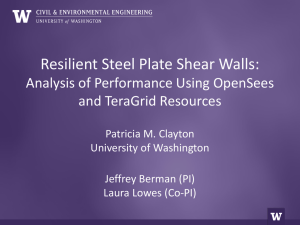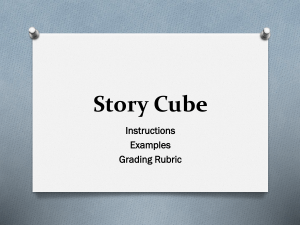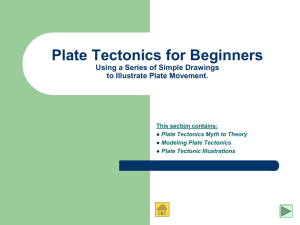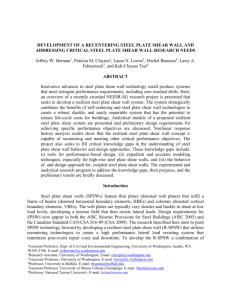UW: Patricia Clayton, David Webster UIUC: Dan Borello, Alvaro
advertisement
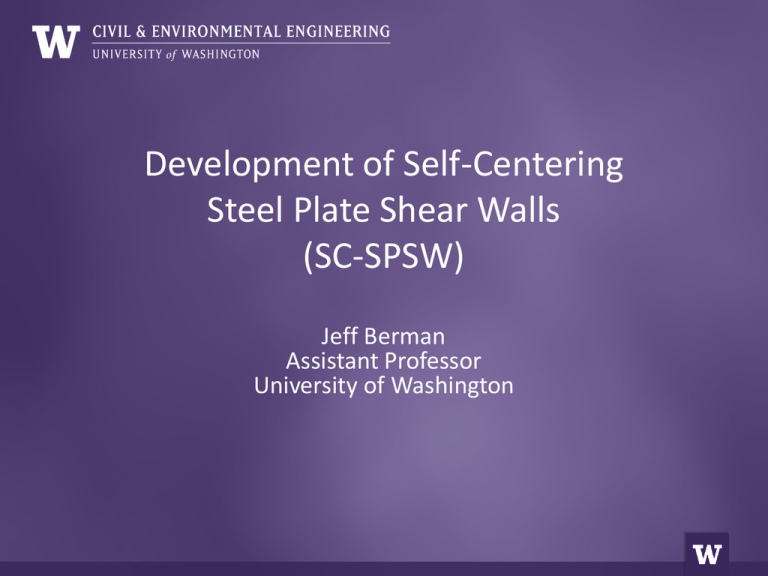
Development of Self-Centering Steel Plate Shear Walls (SC-SPSW) Jeff Berman Assistant Professor University of Washington NEESR-SG: Steel Plate Shear Wall Research Larry Fahnestock K.C. Tsai Jeff Berman and Laura Lowes Graduate Students: UW: Patricia Clayton, David Webster UIUC: Dan Borello, Alvaro Quinonez UB: Dan Dowden Sponsored by NSF through the George E. Brown NEESR Program Material Donations from AISC Michel Bruneau Rafael Sabelli Project Overview Resilient SPSW Analysis and Verification of Performance Fill Critical Knowledge Gaps Subassemblage Testing Shake Table Testing Full-Scale Testing a ~43° Cyclic Inelastic Tension Field Action SPSW Damage States and Fragilities Coupled SPSW Testing (MUST-SIM) Motivation • Current U.S. seismic design codes – Life Safety and Collapse Prevention – Maximum Considered Earthquake (MCE) • U.S. Earthquakes since 19701: – Only 2 people per year die due to structural collapse – $2 billion per year in economic loss 1 ATC-69 (2008) US Northridge Earthquake (1994) Haiti Earthquake (2010) Resilient SPSWs: Motivation • Steel Plate Shear Walls (SPSWs): – – – – – Thin web plates: tension field action High initial stiffness Ductile Distributed yielding Replaceable “fuses” (web plates) • However, – Damage in HBEs and VBEs not as easy to repair/replace How can we limit damage to HBEs and VBEs to provide a quicker return to occupancy following an earthquake? (Vian and Bruneau 2005) Resilient SPSW: SPSW+ PT Frame VPT VSPSW D D VR-SPSW Unloading Plate yields Connection Decompression Plates Unloaded Connection Recompression Previous PT Connection Work: Garlcok et al. 2002, Christopoulos et al., 2002 D 1st Cycle 2nd Cycle SC-SPSW Research Overview Analytical Research System Behavior Performance-Based Design Procedure Analysis and Verification of Performance Experimental Research Subassembly Testing (U. of Washington) Shake Table Testing (U. at Buffalo) Full-scale Testing (NCREE, Taiwan) R-SPSW Mechanics • Distributed loads on frame from web plates • Compression of HBE from three components: – PT – Web plate loads on VBE – Web plate loads on HBE Performance-Based Design REPAIR OF PLATES ONLY V V2/50 V10/50 NO REPAIR V50/50 Vwind COLLAPSE PREVENTION First occurrence of: PT yielding Frame yielding Residual drift > 0.2% Plate yielding First occurrence of: PT rupture Excessive PT yielding Excessive frame yielding Excessive story drifts Connection decompression D50/50 D10/50 D2/50 D Analytical Model • Nonlinear model in OpenSees • SPSW modeled using strip method: • Tension-only strips with pinched hysteresis • Strips oriented in direction of tension field Analytical Model (cont.) • PT connection model: Rocking about HBE flanges Shear transfer Compression-only springs at HBE flanges Diagonal springs HBE VBE PT tendons Truss elements with initial stress (Steel02) Rigid offsets Physical Model Analytical Model Dynamic Analyses • 3 and 9 story prototypes based on SAC buildings: 4-6 SPSW bays • Each model subjected to 60 LA SAC ground motions representing 3 seismic hazard levels • 50% in 50 year • 10% in 50 year • 2% in 50 year • Used OpenSeesMP to run ground motions in parallel on TeraGrid machines Ranger Analytical Summary • Results for typical 9-story SC-SPSW – designed WITHOUT optional 50% in 50 year “No repair” performance obj. • Performance Objectives: – No plate repair (Story drift < 0.5%) in 50/50 – Recentering (Residual Drift < 0.2%) in 10/50 – Story drift < 2.0% in 10/50 (represents DBE) – Limited PT, HBE, and VBE yielding in 2/50 V NO V2/50 V10/50 REPAIR V50/50 REPAIR OF COLLAPSE PLATES ONLYPREVENTION Vwind D50/50 All performance objectives met !!! D10/50 D2/50 D UW Component Tests Reaction Blocks Target Deformation of Specimen Subassemblage Roller to Allow Gap Opening Pin to Allow VBE Rotation Laboratory Configuration Development of tension field R-SPSW Testing Connection decompression Flag-shaped hysteresis Residual web plate deformation after test Comparison of Parameters Change in number of PT strands Change in web plate thickness Kr • Affects recompression stiffness, Kr, due to change in PT stiffness • Affects system strength and energy dissipation • Affects decompression moment • Affects post-decompression stiffness Comparison with Idealized Response VSC-SPSW Unloading Plate yields Connection Decompression Plates Unloaded Connection D Recompression 1st Cycle 2nd Cycle • More energy dissipation than assumed • Some “compressive” resistance due to geometric stiffening Web Plate Behavior Study FE modeling Residual Load Experimental testing Pins (Webster 2011) ~25% of yield strength Comparison with Models • OpenSees model • With and without compressive resistance in strips • Future improvements to strip model: – Modify strain hardening rules to account for cyclic yielding – Quantify compression in SPSW strip model Frame Expansion • As PT connection decompresses, VBEs spread apart Garlock (2002) • Can cause floor damage or increase frame demands if beam growth is restrained, especially at 1st floor beam Kim and Christopoulos (2008) Accommodation of Frame Expansion • Flexible collector beams connecting PT frame and composite slab – Applies additional point loads along beam – Damage to collector beams Garlock (2007) • Sliding interface between slab and beams – Eliminates slab restraint Kim and Christopoulos (2008) Elimination of Frame Expansion • Rocking about HBE centerline (Pin) • NewZ-BREAKSS – Rocking about top flange only Testing at NEES@Buffalo • Quasi-Static tests • 1/3 scale, 3-story • Various PT connection details • Full plate and Strips N ew Z -B R E A K S S C onn. F lange R ocking C enterline R ocking Comparison of Behavior • Flange rocking provides better re-centering because of decompression moment • NewZ-BREAKSS prevents floor damage due to frame expansion. N ew Z -B R E A K S S C onn. F lange R ocking UB Shake Table Tests • 6 degree-of-freedom shake table • Same specimens as quasi-static tests • Scheduled for completion in fall 2012 System-level Testing • National Center for Earthquake Engineering (NCREE) in Taiwan – 2-story, full scale SC-SPSW – Single actuator – Quasi-static loading – Summer 2012 NCREE Specimens • PT column base – Column can rock about its flanges NCREE Specimens • PT column base – Column can rock about its flanges • 2 specimens – Flange rocking HBEs – NewZ-BREAKSS Connection (Top flange rocking HBEs) Conclusions • Performance-based design procedure developed for SCSPSW: – Elastic behavior during frequent events – Web plate yielding and recentering during DBE events – Collapse prevention during MCE events • Analytical studies show SC-SPSWs are capable of meeting proposed performance objectives • Experimental subassembly tests show ‘simple’ models are conservative and have room for improvement • Future testing will verify performance on system level Thank You Questions? 30
